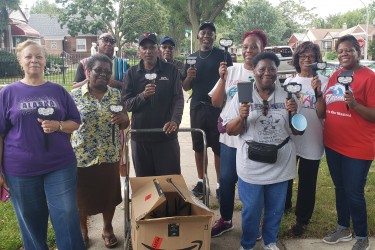MOVING TO YOUR NEIGHBORHOOD
Take Care of the Basics
Well, the final logistics sure aren’t exciting, but they are important.
Update your Address:
Post Office: Visit your local post office or fill out this form online. This also allows you to set up mail forwarding.
DMV: Update your Driver’s License/State ID and vehicle registration by visiting the DMV or filling out this form online. In Illinois, you have 10 days following your move to update these records.
Other Updates: Give a change of address to your banks, schools, friends, family, insurance company, doctors, cell phone provider, credit card companies, and magazine and newspaper subscriptions.
Register to Vote: It’s quick and easy to update and register your new address so you can weigh in on the direction of your new community. While you’re at it, take a moment to learn who your elected officials are.
Discover Amenities and Services
What are the assets in your new community? Do some research and begin exploring!
Schools: You can find your local school and the steps on how to enroll using the CPS School Locator.
Parks District: Take advantage of the free and low-cost recreational opportunities in your new neighborhood offered by the Chicago Park District.
Libraries: Your local library not only has print and online resources available to you for free, but also offers classes, workshops and group gatherings.
Transit: Learn the routes and services available to you in your new neighborhood.
Local: Get out and discover local shopping and dining options in your area (maybe it even has a farmers market!).
Connect
Is there anything more human than connectivity? Embrace your newcomer status and seize the opportunity to connect with others in your community.
Introduce Yourself: Yep, it may seem obvious, but a simple introduction and brief conversation with your neighbors goes a long way in forging supportive relationships (the types that make it easier to find someone to pick up your mail when you go on vacation). It also helps you be a better neighbor when you learn a little about their schedules and lifestyles. Plus, it gives you a chance to talk about shared resources (e.g. “hey, I have a pretty tall ladder if ever you need to borrow it!”).
Attend Community Meetings: Aldermanic Offices and Community Policing (CAPS) Districts usually have standing community meetings, which can be a good way to not only learn about community conversation topics, but also meet other residents.
Attend Neighborhood Happenings: Keep an eye out on local listings or flyers for open events you can attend. Maybe a block party, garage sale or festival will pop up nearby and you can take the opportunity to enjoy the day with your neighbors.
Volunteer: Inquire about volunteer help at a local organization that aligns with your interests. Volunteer opportunities usually bring together people with diverse backgrounds, which can be particularly helpful in expanding your network.
Join a Club: Whether it’s a local hobby group, book club, parenting network or fitness center, it’s bound to bring you together with others in your community.
Take a Class: Check local community centers and colleges for options that interest you. Knock out a few birds with one stone by learning somethings new while meeting people.
Bring People Together: Play host in your home, backyard or street and invite the neighborhood over to socialize. Whether it’s the whole block or just group of friends, everyone loves a reason to come together.
Take Action
Craving more for your neighborhood? Take a look at some of our Community Action resources to take the next steps.

